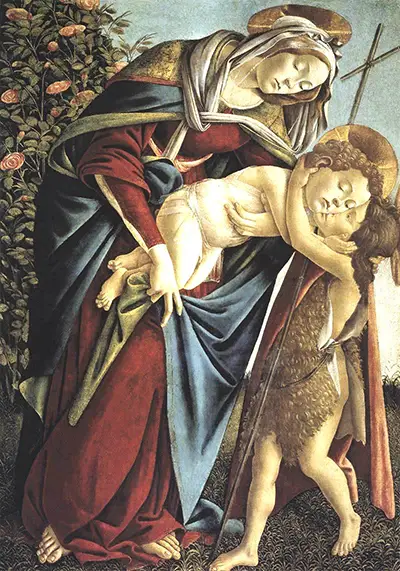 Buy Art Prints Now
Buy Art Prints Nowfrom Amazon
* As an Amazon Associate, and partner with Google Adsense and Ezoic, I earn from qualifying purchases.
This painting is dated at around 1495-1500 and its attribution is either Sandro Botticelli himself, or perhaps from members of his studio. Many of his lesser known artworks such as this have a little cloud hanging over them with regards their sources.
Madonna and Child and the Young St John the Baptist was produced using egg tempera on a single wooden panel. It is believed to now be at the Palazzo Pitti, Florence, Italy and measures 132cm in height, 92cm in width. In this composition we find the madonna holding a child, whilst another figure has his arm wrapped around the youngster. The layout of this artwork gives these three figures pretty much the entire dimensions of the piece, with the only other detail being shrubs with flowers on the left hand side and a portion of blue sky in the background. There is also a carefully crafted grassed ground beneath their feet which the artist adds detail to with a patterned series of sprouting leaves. In some paintings he would devote large amounts of time and energy to the background, and that would sometimes include whole myriads of plants, flowers and trees to fill the whole panel with visual interest.
There is believed to have been a near-identical work that now resides within the Barber Institute in Birmingham, UK. The existence of another version is evidence for some that the artist's workshop may have made their own copies, but perhaps which ever was the original piece may have been from Botticelli's own hand. With the different versions existing in different countries, it will inevitably become difficult to really examine these question marks in greater detail. The version remaining in Italy has been more widely accepted as Botticelli's own within the last few decades, ever since it was cleaned and restored, allowing acacdemics to better evaluate its content.
This painting has been attributed to Botticelli since around the middle of the 19th century, and prior to that there was relatively little interest in this artist's career. It seems peculiar today the such an impressive painter who have been ignored for several centuries, but their loss is our gain and today Botticelli's most famous paintings are regarded as iconic images from the Early Renaissance. The most popular two would have to be The Birth of Venus and Primavera which have both been examined in huge detail in recent years as historians attempt to understand every last detail about them. It is normally the artworks owned by the major galleries which receive this treatment because it is those institutions that can source the necessary techniques and expertise.




